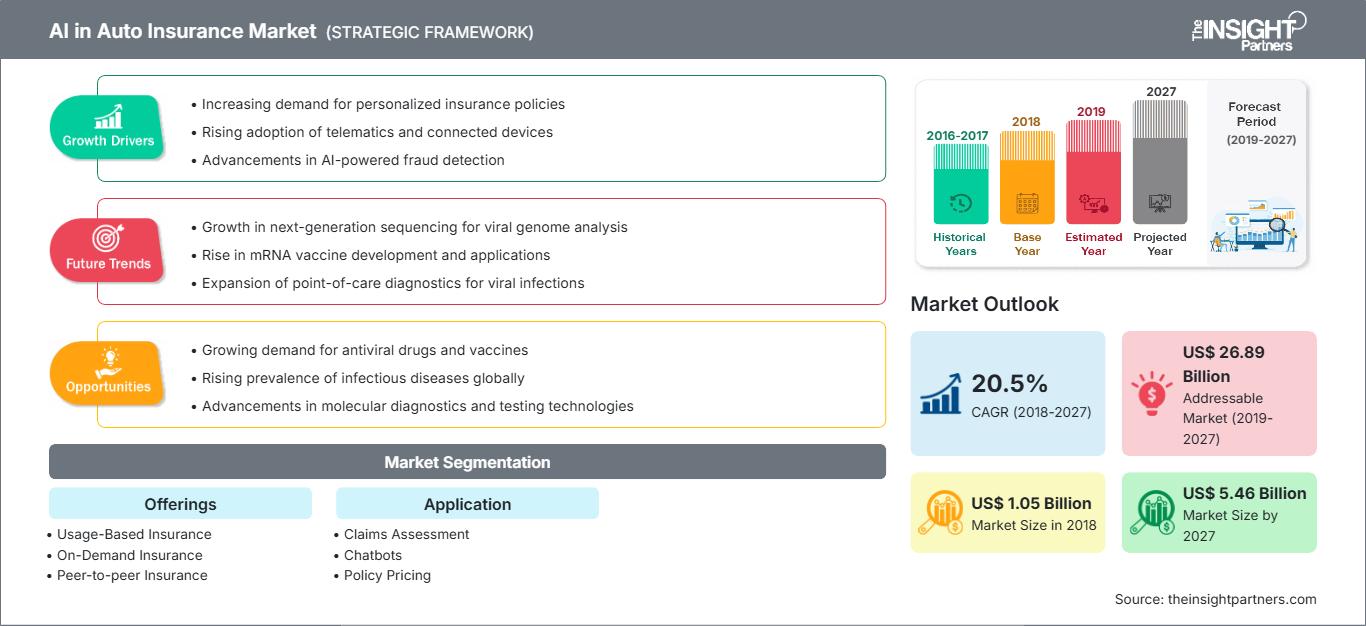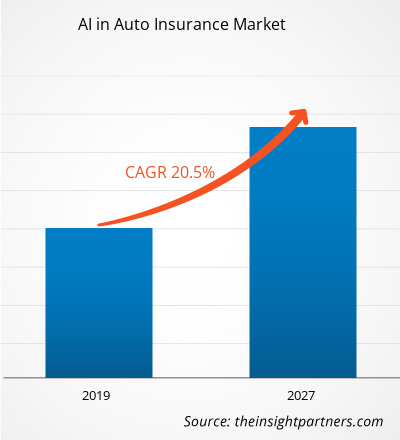[研究报告]2018年,汽车保险市场的人工智能规模达到10.4756亿美元,预计在2019年至2027年的预测期内,复合年增长率将达到20.5%。
云端人工智能解决方案在各种业务功能中相对于本地解决方案的渗透率不断提高,预计将推动汽车保险行业人工智能应用的增长。本地人工智能解决方案有时很复杂、昂贵,企业难以内部构建。由于庞大的基础设施和技术专业知识需求,并非所有中型企业,甚至某种程度上的大型企业,都认为投资内部开发和部署人工智能技术是可行的。
当今云平台的先进功能和不断发展的架构正在推动包括保险在内的每个垂直行业采用基于云的解决方案。低初始投资、成熟的云计算和托管模式、高级功能和按需变化是推动保险公司采用云解决方案的一些主要因素。投资云解决方案不仅有助于公司扩大运营规模,还能增强成本和生产力控制。除了这些因素之外,每个组织的业务需求各不相同,因此需要定制化的解决方案,而使用基于云的解决方案来满足这些特定需求被认为是全球大多数公司的最佳商业模式。预计所有这些因素将在2019年至2027年的预测期内推动汽车保险市场对基于云的人工智能解决方案的需求。
自定义此报告以满足您的要求
您将免费获得任何报告的定制,包括本报告的部分内容,或国家级分析、Excel 数据包,以及为初创企业和大学提供超值优惠和折扣
汽车保险市场中的人工智能: 战略洞察

-
获取本报告的主要市场趋势。这个免费样本将包括数据分析,从市场趋势到估计和预测。
市场洞察:人工智能的最新趋势和应用将推动未来增长
随着电动汽车和自动驾驶汽车领域的技术进步,全球汽车行业正在经历一场变革。随着安全功能和无人驾驶技术的不断增加,预计未来几年汽车保险行业可能会大幅萎缩。汽车保险行业占全球保险业的很大一部分,对于汽车保险公司来说,专注于产品和服务创新对于在 2019 年至 2027 年的预测期内保持利润至关重要。人工智能可以通过将技术整合到现有产品和服务组合中来帮助保险公司和经纪人获利,这种技术趋势很少。这些主要趋势包括行为保单定价、客户体验和保险范围的个性化以及定制化理赔。随着物联网 (IoT) 设备的数量不断增加,客户群体也日益多样化,提供个性化服务的机会正在快速增长。行为保单定价利用定价平台中这些物联网传感器收集的个人数据。这给遵守安全指示的驾驶员带来了优势,因为他们需要支付的汽车保险费用更少,这也被称为基于使用情况的保险。借助聊天机器人,人工智能还可以根据客户的地理位置、社交媒体、在线购物和其他因素相关的数据,为客户提供无缝的购买体验。定制保险或按需保险是另一项好处,客户可以通过它针对某些特定事件/项目获得定制保险。借助虚拟理赔员和在线界面,人工智能可以帮助客户更快、更高效地解决索赔。人工智能的所有这些优势也有助于减少欺诈事件。因此,随着人工智能在汽车保险行业的各种功能和即将到来的应用,预计汽车保险市场的人工智能在 2019 年至 2027 年的预测期内将出现巨大增长。
提供市场洞察
汽车保险市场的人工智能按产品细分为基于使用情况的保险、按需保险和点对点保险。人工智能能够促进包括经纪人、投保人和保险公司在内的各方群体节省开支,并融入保险行业现有的转型。Cuvva、Trov 和 Metromile 等公司负责处理完整的保险购买流程。
汽车保险市场中的人工智能
The Insight Partners 的分析师已详尽阐述了预测期内影响汽车保险市场人工智能的区域趋势和因素。本节还探讨了北美、欧洲、亚太地区、中东和非洲以及南美和中美洲汽车保险市场人工智能的细分市场和地域分布。
汽车保险市场中的人工智能报告范围
| 报告属性 | 细节 |
|---|---|
| 市场规模 2018 | US$ 1.05 Billion |
| 市场规模 2027 | US$ 5.46 Billion |
| 全球复合年增长率 (2018 - 2027) | 20.5% |
| 历史数据 | 2016-2017 |
| 预测期 | 2019-2027 |
| 涵盖的领域 |
By 产品
|
| 覆盖地区和国家 |
北美
|
| 市场领导者和主要公司简介 |
|
汽车保险市场参与者密度中的人工智能:了解其对业务动态的影响
汽车保险市场的人工智能 (AI) 正在快速增长,这得益于终端用户需求的不断增长,而这些需求又源于消费者偏好的不断变化、技术进步以及对产品优势的认知度不断提升等因素。随着需求的增长,企业正在扩展其产品线,不断创新以满足消费者需求,并利用新兴趋势,从而进一步推动市场增长。

- 获取 汽车保险市场中的人工智能 主要参与者概述
全球汽车保险人工智能市场已根据应用细分为理赔评估、保单定价和聊天机器人。互联网功能的高度渗透促进了先进技术的发展,从而节省了各方的时间和成本。
保险行业的人工智能已经取代了传统的理赔管理流程,使其更快、更高效,并最大限度地减少了错误。新的理赔管理流程支持保险公司通过以最佳方式优化技术,实现更高效的理赔管理。创新的理赔评估流程提供实时问答服务,便于首次通知,在自动化损失评估流程的同时进行理赔预评估,预测理赔量模式,借助丰富的数据分析自动检测理赔欺诈,并增强损失分析。在理赔管理流程中采用人工智能和机器学习,有可能使保险公司和保险公司都受益,显著节省处理成本和时间,并显著提高服务质量。
全球汽车保险人工智能细分领域:汽车保险市场中的人工智能 -
按产品分类- 基于使用情况的保险
- 按需保险
- 点对点保险
汽车保险市场中的人工智能 – 按应用分类
- 理赔评估
- 聊天机器人
- 保单定价
汽车保险市场中的人工智能 –
- 按地理位置
-
北美洲
- 美国
- 加拿大
- 墨西哥
-
欧洲
- 法国
- 德国
- 意大利
- 西班牙
- 英国
- 欧洲其他地区
-
亚太地区 (APAC)
- 澳大利亚
- 中国
- 印度
- 日本
- 亚太地区其他地区
-
中东和非洲 (MEA)
- 沙特阿拉伯
- 阿联酋
- 南非
- MEA 其他地区
-
南美洲 (SAM)
- 巴西
- SAM 其他地区
公司
- 蚂蚁金融服务集团有限公司
- CCC Information Services Inc.
- Claim Genius Inc.
- Clearcover, Inc.
- 微软公司
- GEICO
- ICICI Lombard General Insurance Company Limited.
- Nauto, Inc.
- Solaria Labs(利宝互助保险)
- The Progressive Corporation
- 历史分析(2 年)、基准年、预测(7 年)及复合年增长率
- PEST和SWOT分析
- 市场规模、价值/数量 - 全球、区域、国家
- 行业和竞争格局
- Excel 数据集
近期报告
相关报告
客户评价
购买理由
- 明智的决策
- 了解市场动态
- 竞争分析
- 客户洞察
- 市场预测
- 风险规避
- 战略规划
- 投资论证
- 识别新兴市场
- 优化营销策略
- 提升运营效率
- 顺应监管趋势






















 获取免费样品 - 汽车保险市场中的人工智能
获取免费样品 - 汽车保险市场中的人工智能